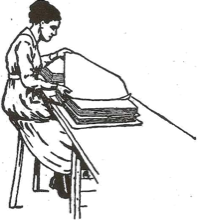Reference: [2] Handmade Paper in Tuckenhay Devon by Catherine Cox (1977)
|
The Glazer The mechanics of the glazer or the roller, as she is sometimes called, are zinc plates, two pieces of wood about twenty inches long, and four inches square, and a crib, which is made of wood, two sides of which are open, while the other two sides are built up four or five inches high. With the book to be emptied stood on the two pieces of wood to the right hand side of the roller, she fans out the zinc plates towards the crib, which she has in front of her, with the two open sides to her right, and immediately in front of her. She starts to fill the book by turning the top plate over into the crib, having fanned out the paper to the top of the crib on the left side. She continues to fill the book with one sheet of paper, one sheet of zinc plate, until the last plate, which she turns upside down. A book is about thirty two or thirty four sheets depending on the surface needed. On the other side of the bench from which the roller picks up the zinc plates, sits her mate taking the sheets of paper off the plate with her right hand, which she passes into a smaller crib with her left hand. The filled book is taken from the crib by a man, who passes it through large rollers, first the long way of the sheet and then the short way. Hot press books are filled in in exactly the same way, only the taker-out stands on the same side as the filler-in, and does not use a crib, but slips the sheet off the cardboard plate with her right hand, and keeps the sheet straight with her left hand. When the book is filled it is put into a press, with a hot plate between each book, which has been heated in a small oven. |
The hot pressed sheets are the ones that have come through the mill as felt wash, from the vat-house, which originates from a new post of felts, and for two posts after washing the felts, until all the hairs are gone. After hot pressing, the sheets were scraped both sides with a large carving knife, and you can imagine how easy it was for a beginner to slice a sheet in half if the knife was not held right. The Sorters With a heap of paper in front of her, the sorter makes four piles around her on the bench, Best, Best Retree, Worst Retree, and Broken. This is where the faults of each department shows up. The Vatman's, and Coucher's drops, the slipped and bruised sheets of the Layers, dog ears of the Dryer, chilled sizestaincd and wrinkled sheets from the Sizehouse and the Parters, the cut sheets and rough edges of the Glazers. Notepaper and envelopes after being sorted were torn by hand, the marks for tearing was made on the mould in the vat-house. To be a good tearer one needed a good wrist movement. The Finisher When sorted, the paper is counted into quires by the finisher, who makes them up into reams of four hundred and eighty sheets, five hundred for envelopes. Over night the reams are left in the press ready to be packed into neat parcels, ready for customers the world over. |
Reference: The Story of Handmade Paper (1924)

Parting sheet from sheet to give durability and a fine grain